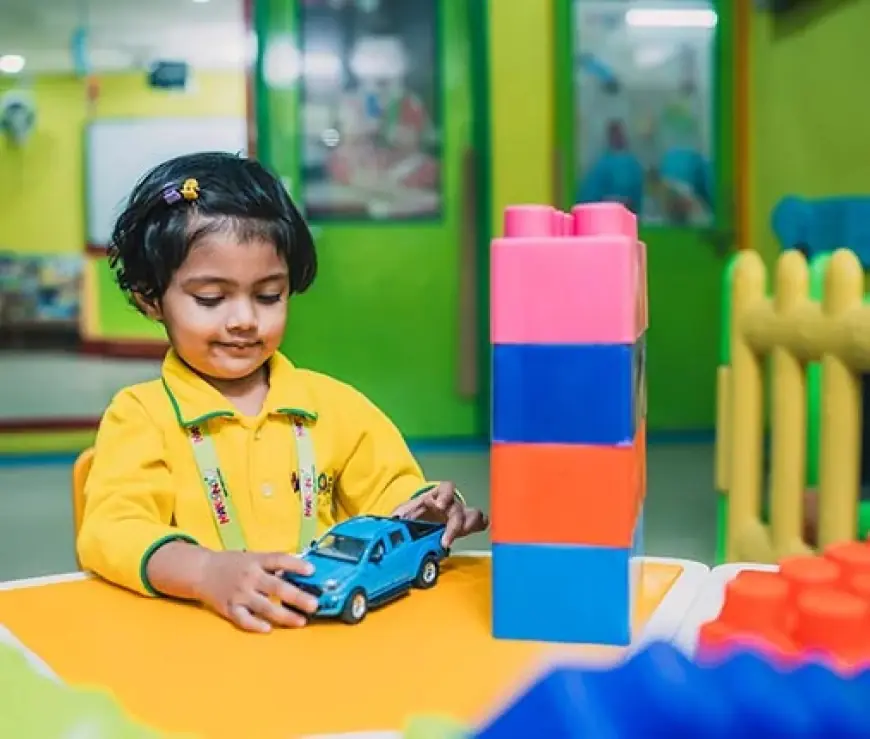Rainy Day Skin Infections in Kids: Causes and Prevention
In this blog, let’s explore the common causes of skin infections during rainy months and, most importantly, practical ways to prevent them.

The monsoon season brings joy to little ones with splashes in puddles, paper boats, and the refreshing coolness after the scorching summer. But while rainy days are a delight for children, parents often face a less cheerful concern—skin infections in kids. The warm and humid climate during rains creates the perfect breeding ground for fungi, bacteria, and viruses. Children playing outdoors, especially in rainy conditions, are more vulnerable, as their developing immune systems offer limited resistance.
As moms and dads hurry to drop their children at kids’ schools, play schools, or even leading institutions like the 5 best schools in India for LKG, ensuring good health becomes just as important as academics. For families considering a play school franchise or planning admissions into pre-primary learning centers, awareness around hygiene and seasonal infections matters greatly. After all, a child who feels healthy can focus better on learning, growing, and playing.
Why Rainy Days Trigger Skin Infections in Kids
Moisture is the biggest culprit during the monsoon. With humidity levels so high, sweat and dampness create an environment where fungus and bacteria thrive. Prolonged wet clothes, dirty rainwater, and unhygienic surroundings further increase risk. Here are the primary causes:
1. Fungal Infections (Ringworm & Athlete’s Foot)
-
Fungi grow rapidly on damp skin, especially in folds like the armpits, behind the knees, and between toes.
-
Common rainy-day complaints include ringworm infections, itchy red circular rashes, or Athlete’s Foot.
2. Bacterial Skin Infections
-
Playing in stagnant rainwater can expose children to bacteria.
-
This may lead to conditions like impetigo, where fluid-filled blisters appear, often contagious in schools and play schools.
3. Allergic Reactions & Rashes
-
Synthetic or damp clothes may trap moisture, causing itchy rashes and irritation.
-
Sensitive young kids, especially preschoolers, experience flare-ups due to weak skin barriers.
4. Viral Skin Problems
-
Viruses thrive in unhygienic rainy surroundings and can spread through contact in crowded classrooms or daycare centers.
-
Hand, Foot, and Mouth Disease (HFMD) is a classic example parents need to watch out for in kids’ schools.
Signs Parents Should Watch Out For
If you have a child in a play school or preparing for admission in one of the best schools in India for LKG, lookout for these indicators:
-
Reddish or itchy patches on skin
-
Fluid-filled blisters
-
Continuous scratching, especially at night
-
Sores that spread from one area to another
-
Thick white patches (common in fungal infections)
Early identification helps in timely treatment, preventing further spread within schools or daycare environments.
Prevention Tips: Protecting Kids from Skin Infections During Monsoon
1. Keep Skin Dry and Clean
Ensure your child changes out of wet clothes immediately after returning home or from school. Cotton-based outfits allow skin to breathe better compared to synthetic materials.
2. Footwear Hygiene Matters
During rainy days, boots or sandals dry quicker than heavy shoes. Keeping extra socks in your child’s kids’ school bag ensures they don’t sit in damp clothing for long.
3. Safe Bathing Habits
Even if your child doesn’t get drenched in rain, insist on a quick bath after outdoor play. Adding mild antiseptic drops or neem leaves to bathwater helps reduce bacteria and fungi.
4. Boost Natural Immunity
A balanced diet with vitamin C, zinc, and probiotics strengthens your child’s ability to fight infections. Schools—especially structured institutions like the 5 best schools in India for LKG—often emphasize nutrition in midday meals.
5. Clean School Bags and Uniforms
Often overlooked, damp school bags and unwashed uniforms become hotspots for germs. Regular washing and sun-drying are musts, especially in the monsoon season.
6. Teach Personal Hygiene
At play school age, children learn the basics of washing hands, not sharing towels, and reporting discomfort. A play school franchise with a structured curriculum also focuses on hygienic habits in routines.
The Connection Between Healthy Kids and Quality Schools
Many parents prioritize academics while shortlisting schools. But whether you are considering a play school, a play school franchise, or getting admissions into the 5 best schools in India for LKG, health and safety should come first.
Why?
-
Young children are natural explorers—they touch surfaces, share toys, and eat snacks together. This increases the chance of infection spread.
-
A good kids’ school ensures sanitized classrooms, sun-dried mats, clean washrooms, and first-aid responses if a skin issue arises.
-
Leading institutions often partner with pediatric specialists or run regular health check-ups as part of their curriculum.
Parents should evaluate not just academics but also how a school maintains hygiene during challenging seasons like the monsoon.
Choosing the Right Play School During Monsoon Season
If you are planning to enroll your child in a play school or weighing the option of investing in a play school franchise, here’s what to look for during rainy months:
-
Hygienic Infrastructure – Look for well-ventilated classrooms, adequate washrooms, and safe flooring that doesn’t trap dampness.
-
Health Protocols – Schools should have checks on uniforms, nails, and hygiene.
-
Awareness Activities – Some leading kids’ schools conduct "Rainy Season Hygiene Weeks" where teachers demonstrate hand washing, drying socks, and covering wounds.
-
Communication with Parents – In reputed schools (including some of the 5 best schools in India for LKG), teachers proactively inform parents if outbreaks like ringworm or viral blisters occur.
Home and School Partnership: Working Together for Healthy Kids
Children spend most of their waking hours either at home or in schools. A strong partnership between parents and educational institutions ensures better health outcomes. For example:
-
At play schools, teachers can ensure kids don’t share personal towels or pillows during nap time.
-
Parents, on the other hand, can provide waterproof jackets, sanitizer, and an extra set of clothing during the monsoon.
-
In play school franchises designed with systematic hygiene policies, parents get advisory circulars about seasonal risks, ensuring consistent prevention both at home and in classrooms.
When to See a Doctor
Despite all precautions, sometimes infections do occur. Parents should consult a pediatrician if:
-
Rashes spread rapidly within 24–48 hours.
-
There is pus discharge or foul smell from sores.
-
Children develop fever along with skin problems.
-
Usual home remedies (like calamine lotion or antifungal creams) are ineffective.
Remember, untreated infections can spread to siblings or even classmates in kids’ schools quickly. Timely medical help avoids complications.
Final Thoughts
The rainy season is meant for fun-filled childhood memories—paper boats, dancing in the rain, and cozy family time. But for parents, keeping children safe from skin infections is equally important. By combining healthy practices at home with safe and hygienic environments in schools, play schools, or even the top institutions like the 5 best schools in India for LKG, kids can enjoy monsoon to the fullest without unnecessary illness.
Whether you’re looking for the perfect kids’ school, exploring a reputed play school franchise, or ensuring your little one’s LKG admission in the best schools, remember: a healthy child is a happy learner. Prioritize hygiene, stay alert, and let the rains bring joy, not skin worries.
Read more :https://makoons.com/blogs/difference-between-playschool-vs-preschool-a-complete-guide/
What's Your Reaction?
 Like
0
Like
0
 Dislike
0
Dislike
0
 Love
0
Love
0
 Funny
0
Funny
0
 Angry
0
Angry
0
 Sad
0
Sad
0
 Wow
0
Wow
0






















































